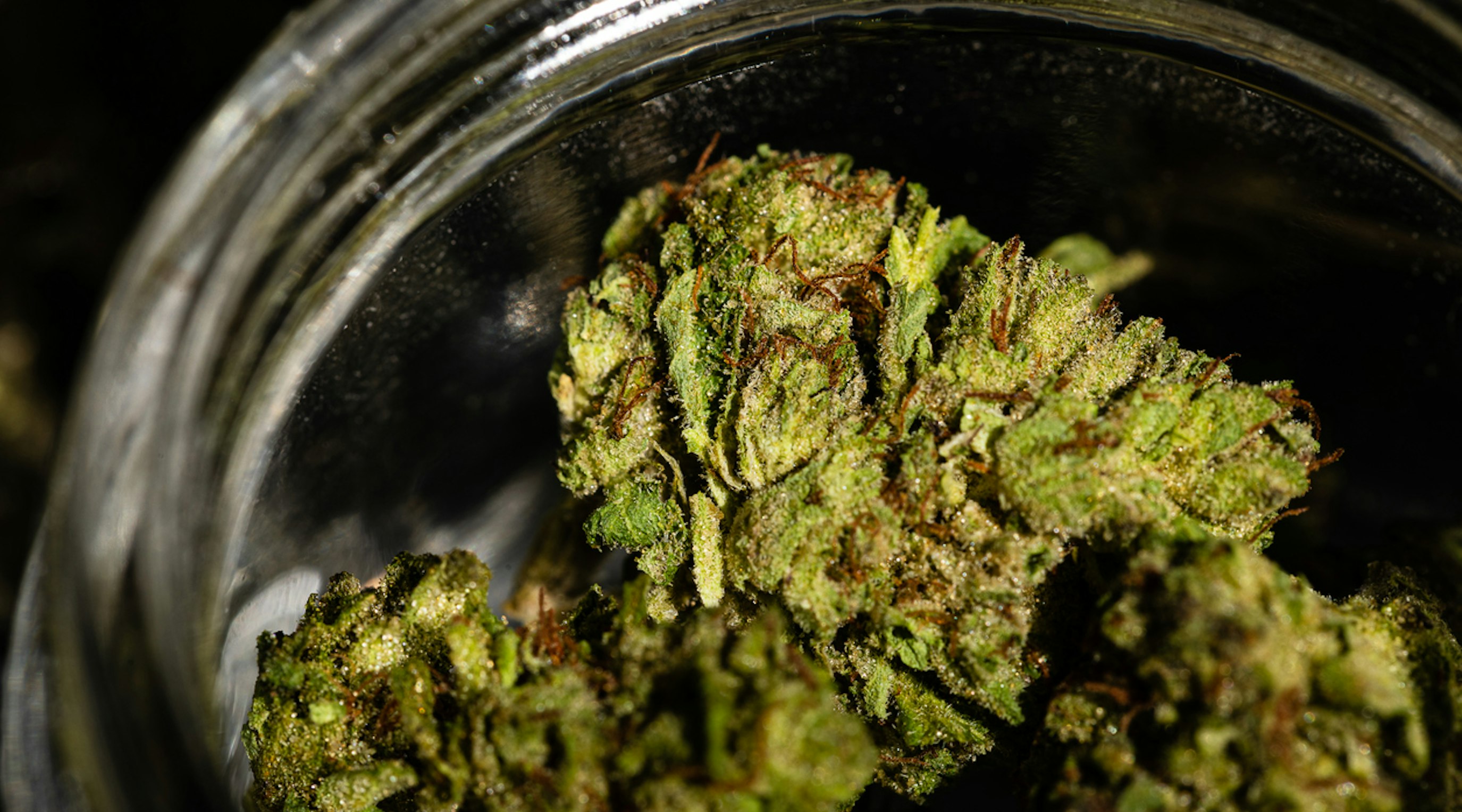Can medical cannabis help people with Ehlers-Danlos syndrome?
11 min read
Sam North
Yes, cannabis-based therapy options are showing huge promise in helping reduce chronic pain, sleep disturbances, gastrointestinal upset, muscle spasms and stiffness, anxiety, and also the reliance on heavy (and sometimes totally ineffective) pharmaceutical options that come along with the diagnosis of Ehlers-Danlos syndrome (EDS).
Contents
Unfortunately, here in the UK, the NHS is unwilling to offer medical cannabis prescriptions to people with Ehlers-Danlos syndrome, due to the lack of clinical evidence on its effectiveness for EDS specifically. However, many individuals with EDS are turning to medical cannabis as a form of alternative/complementary medicine, and the results have been overwhelmingly positive.
Thankfully, private medical cannabis clinics (like Releaf) offer UK patients another way to access medical cannabis for Ehlers-Danlos syndrome, when the National Health Service is hesitant to do so.
With Ehlers-Danlos Syndromes Awareness Month finishing up today, we thought it was perfect timing to dive into how medical cannabis may help Ehlers-Danlos Syndrome patients.
What is Ehlers-Danlos syndrome?
Ehlers-Danlos syndrome is a group of thirteen connective tissue disorders, with three types that are most commonly diagnosed.
- Hypermobile EDS (hEDS): This is the most common form of EDS, with symptoms including chronic pain, joint hypermobility, and skin that is overly elastic or 'stretchy'. Joints may fully or partially dislocate easily and frequently, causing further pain and mobility issues.
- Classical EDS (cEDS): This form of EDS is marked by extremely elastic skin that is also fragile and very easily bruised, as well as severe joint hypermobility. Again, dislocation of the joints is common.
- Vascular EDS (vEDS): vEDS is the most serious type of EDS and can lead to severe health complications caused by extremely fragile blood vessels and internal organs.
But, other types of EDS are far rarer. The Ehlers-Danlos Society predict less than 1 in 1 million people are affected by:
- Periodontal EDS (pEDS)
- Kyphoscoliotic EDS (kEDS)
- Spondylodysplastic EDS (spEDS)
- Brittle Cornea Syndrome (BCS)
- Arthrochalasia EDS (aEDS)
- Musculocontractural EDS (mcEDS)
- Classical-like EDS (cIEDS)
- Dermatosparaxis EDS (dEDS)
- Myopathic EDS (mEDS)
- Cardiac-valvular EDS (cvEDS)
What causes EDS?
EDS is a genetic disorder that is almost always inherited. Unlike some genetic disorders, where both parents need to be carriers of the mutated gene, EDS can be passed down from just one parent. In a very small number of cases, EDS can be caused by a new mutation that appears spontaneously and not through inheritance.
There are more than 19 genes that can cause EDS, and these genes play a role in making collagen. Collagen is a vital protein that provides strength and elasticity to connective tissues. When one or more of these genes mutate, one of the many forms of EDS can be the outcome.
How is Ehlers-Danlos syndrome diagnosed?
One of the big issues that people with EDS face is misdiagnosis.
The syndrome is often overlooked, in part because the complexity of its symptoms varies from person to person. Genetic testing can confirm the diagnosis by identifying the specific gene mutations, but patients might not be sent for genetic testing if the doctor is not familiar with EDS or its many forms.
The problem is that the presenting symptoms can often masquerade as a variety of other health issues — including fibromyalgia, multiple sclerosis (MS), and lupus. Joint hypermobility and chronic pain are a feature of many other medical conditions, which can lead to an incorrect diagnosis and a delay in treatment.
EDS is a rare condition, and doctors may not have the training or knowledge needed to identify and diagnose it properly. GPs may see the symptoms, try their best to find a cause, and even send the patient off to a specialist—but the specialist might not be familiar with EDS or may be the wrong specialist to diagnose it.
If you think you may have EDS but are struggling to get a diagnosis, it's always worth seeking out the opinion of an EDS specialist. Rheumatologists and geneticists are usually the best doctors to consult with for a EDS diagnosis.
What are the traditional treatments for Ehlers-Danlos syndrome?
Conventional approaches for EDS focus on managing symptoms and improving quality of life, as there is, unfortunately, no known cure.
Traditional treatments may include:
- Physical therapy to help strengthen muscles and improve joint stability
- Medications such as painkillers (usually opioids), anti-inflammatories, and muscle relaxants
- Braces or joint supports to help provide stability and reduce pain
- Counselling or therapy to help manage the emotional impact of this debilitating syndrome.
- Surgery may be recommended in severe cases where joint instability or organ damage is present.
Can medical cannabis offer people with EDS hope?
Yes, at least that's what many people with EDS are finding.
While clinical trials specifically focusing on exactly how medical cannabis options help with reducing the symptoms of EDS are still lacking, there is a wealth of emerging anecdotal evidence and one very interesting case study to look at.
The Lucy Stafford case
Lucy Stafford, now in her 20s, was diagnosed with EDS and had already had her first surgeries trying to fix her frequent joint dislocations by the age of 10. This was followed by almost permanent hospital stays and another 19 operations during her teenage years.
By the age of 17, she was finding it almost impossible to leave her bed and had been prescribed fentanyl (a synthetic opiate that is around 100 times stronger than heroin), morphine, and buprenorphine to help with her chronic pain, and diazepam (Valium) to help with her anxiety levels.
Despite this cocktail of heavy pharmaceuticals, she was still in pain and had very little quality of life. She is quoted in this BBC article as saying:
"I felt I couldn't focus, I dropped out of school when I was 15. I used to sleep 18 hours a day because I was just so exhausted, and so my muscles wasted. I was at the point where I would have done anything to manage my pain"
Obviously at her wit's end, Lucy decided that enough was enough. After a discussion with her doctor, the decision was made to try medical cannabis. But when her doctor tried to prescribe her medical cannabis, the NHS flatly denied the request.
With no other choice, Lucy boarded a flight to Amsterdam, headed to one of the many 'coffee shops', and tried cannabis. Within a few days of taking her first vaporised cannabis flower, both her chronic pain levels and muscle spasms subsided considerably.
On her return to the UK, she began taking cannabis (first through the black market, but she was quickly able to receive a prescription through a private medical cannabis clinic), and within three months, she had got to the point where she could stop taking all of the opiate medications, and her recurrent bladder infections had ceased.
In this 3 month period, she did not have to go to A&E for emergency treatment at all, but in the three months leading up to this point, she was there five times. In the year before starting medical cannabis treatment, she spent 54 days as a hospital inpatient - in the year after, this dropped to just five days total.
When she was interviewed by the BBC, she said:
"It is literally the only thing that gets me out of bed and being able to work, and being able to study and being able to live a life now." and "I have no idea whether I would still be here if I was on my previous treatment. We were at the end of the line, and it was my last hope, so I would say it saved my life."
These changes to her mobility, pain levels, and overall quality of life are nothing short of extraordinary and have allowed her to start once more with physiotherapy to help further her recovery, where she was previously too tired and sore, and her mobility was too limited to undertake such treatments.
How does medical cannabis help with Ehlers-Danlos syndrome?
While the evidence here is still largely anecdotal, there are some potentially very good reasons why medical cannabis may be beneficial for those suffering from EDS-related symptoms.
This write-up on the Ehlers-Danlos Support UK website provides some great insight. They interviewed Dr Dani Gordon, a Canadian British doctor now practising in the UK and a leading voice in the medical cannabis field.
“In general, I find medical cannabis is one of the best quality-of-life medications for EDS because it affects multiple systems and symptoms across multiple domains,” says Dr Gordon “EDS is not just about being hypermobile, like many of us are taught in medical school, patients also suffer from a number of symptoms that can be difficult to treat and are often misdiagnosed. When you have this correlation of chronic pain, fatigue and poor sleep, which is often what EDS patients experience, medical cannabis can help with all these symptoms. Although it’s not a cure, in my experience, it often works better, with less side effects than the medications they are currently taking.”
Releaf's board certified Rheumatologist and medical cannabis prescriber Dr Hanna Gul medical director added:
"Ehlers Danlos Syndrome (EDS) is a group of inherited disorders affecting connective tissues, characterised by joint hypermobility, skin hyperextensibility and tissue fragility. Managing EDS can be challenging due to chronic pain, joint instability and other symptoms including those related to changes in blood pressure and increased heart rate, fatigue, cognitive disturbance and bladder/bowel disturbances. Medical cannabis holds potential as a complementary treatment for pain management, muscle relaxation, improved sleep and reducing anxiety. EDS patients using medical cannabis often report improvements in these symptoms, in addition to improvement in overall quality of life."
But how does cannabis-based medicine do all of this?
Cannabis interacts with our endocannabinoid system, along with a range of other receptor sites in our body, such as those for pain regulation, serotonin, and dopamine.
The endocannabinoid system is a homeostatic system that works to bring balance to the brain and the body in many different ways. It is the largest neurotransmitter system in the body, and its receptors are found throughout the central and peripheral nervous systems.
The endocannabinoid system helps to regulate pain perception, inflammation, immune responses, mood, sleep, appetite, digestion, and many other bodily functions. It is also involved in neuroprotection and neuroregeneration processes.
In the Ehlers-Danlos Support UK website article, Dr Dani Gordon puts it this way
"Just like many other chronic conditions with symptoms that cross multiple systems in the body, EDS is one of those diseases where medical cannabis is particularly beneficial, because there are cannabinoid receptors in most of our tissues throughout the brain and body, and the endocannabinoid system has so many diverse functions. Because of this, we tend to see relief from symptoms that don't necessarily appear to be connected."
And then there are the secondary symptoms of EDS, like anxiety, depression, and PTSD. For many people with these conditions, medical cannabis can be a real game-changer.
Final thoughts
While clinical research is still lacking, hopefully, in the coming years, more scientific investigation will be carried out to work out the precise mechanisms behind how medical cannabis helps those with EDS. But for now, the anecdotal evidence combined with the emerging science seems to be pointing in a very promising direction.
If you would like to learn more about the potential benefits of medical cannabis for EDS, feel free to reach out at any time. We also have an extensive blog and education section, where you can find more information on all things medical cannabis.
Share article
Did you like this article?
It is important to seek medical advice before starting any new treatments. The patient advisors at Releaf are available to provide expert advice and support. Alternatively, click here to book a consultation with one of our specialist doctors.
Elevate your wellness with medical cannabis
Get comprehensive care, convenience, and confidence with an all-in-one treatment plan.
Am I eligible?Authors
Sam North, a seasoned writer with over five years' experience and expertise in medicinal cannabis, brings clarity to complex concepts, focusing on education and informed use.
Editorial Policy
All of our articles are written by medical cannabis experts, guided by strict sourcing guidelines, and reference peer-reviewed studies and credible academic research. Our expert clinical team and compliance specialists provide valuable insights to ensure accuracy when required. Learn more in our editorial policy.
Need more help?











